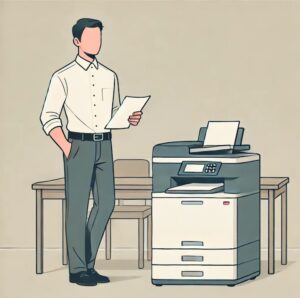After the first laser printer was invented in 1971, laser printers have become a staple of many commercial office buildings and homes. Laser printers are best suited for commercial offices that print a lot of text heavy documents. But how exactly does a laser printer use a beam of light to print an image on a piece of paper? The whole process oddly sounds like it could be science fiction, but it really is simple science. Here’s a step-by-step process of how an image goes from your computer, then through your laser printer, and onto the printed page:
From Photocopier To Laser Printer
While an inkjet printer uses liquid ink to print an image or text, a laser printer uses a powdery substance called toner. Laser printers are quite similar to photocopiers, as they both use the same basic technology to print images. In fact, the first laser printers were built from modified photocopiers. The biggest difference between the two is that while the photocopier uses a bright light to copy a printed page, the laser printer has to create the image or text from scratch.
Data Turns Into Electricity
The computer stores your text and images in the form of electronic data. Then, the laser printer converts this electronic data back into the text or image you want to print. Millions of bytes of this data stream from your computer into the printer. An electronic circuit inside the printer then figures out how to print this data onto the page. This circuit activates a high-voltage wire called the corona wire, which charges the photo receptor drum with static electricity. It gains a positive charge that’s spread evenly across its surface.
Positive Vs. Negative Charges
The circuit also activates a laser beam that scans back and forth across the drum inside the printer. The laser beam itself doesn’t move. It bounces off a moving mirror that draws the image of the page onto the drum. Everywhere the laser hits on the drum, a negative charge replaces the positive charge. An ink roller then coats the photo receptor drum in the powdered toner, which has been given a positive electrical charge. This positive charge allows the toner to stick to the parts of the drum with a negative charge, since the opposite charges attract.
Fusing Toner To Paper
Next, a sheet of paper is fed toward the drum, being given a positive electrical charge by a separate corona wire. The positively charged paper attracts the negatively charged toner from the drum. This is when the image is transferred onto the paper. However, toner is not yet fused to the paper, so the sheet then passes through the fuse unit. These two hot rollers use heat and presser to permanently fuse the toner with the paper. Then voila! The printed sheet comes out of the side of the copier.
So, maybe comparing laser printers to science fiction is a stretch, but the technology is still impressive and efficient. Printing from your business or home saves you time and money. Check out our Printer Page to see what you can save when you buy our printers.


